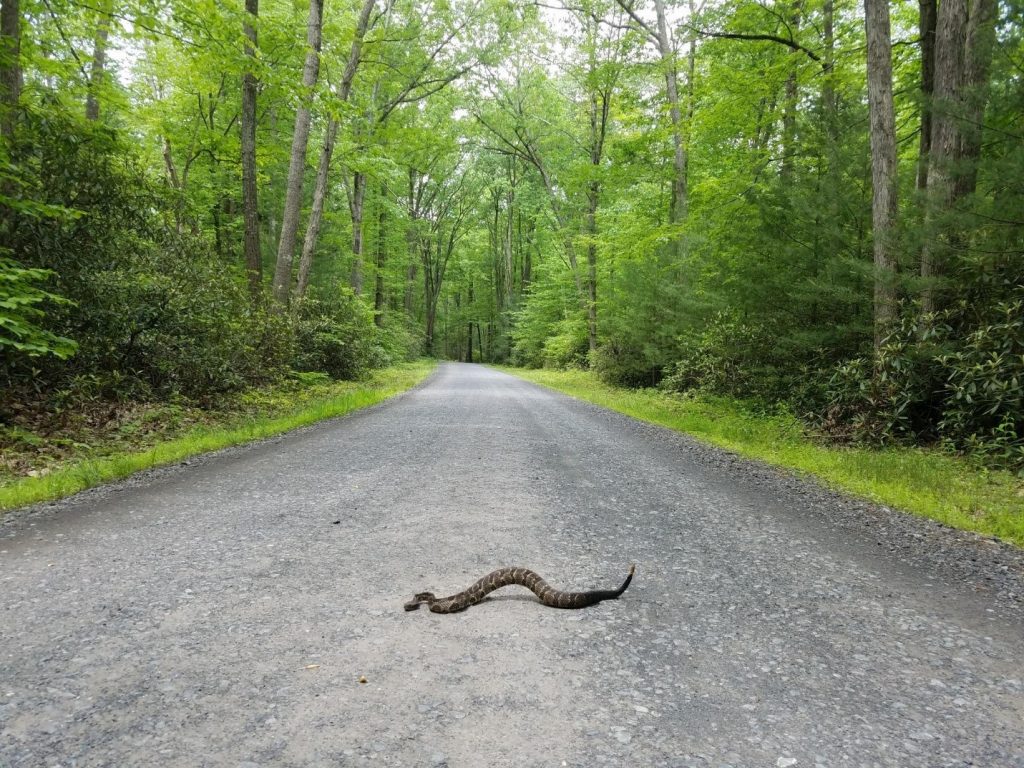Buzztails on the move was in the back of my mind as I was hiking to a vegetation plot in the study area. Scenes like this one are a common sight in the summer as timber rattlesnakes search for mates. And then I saw them… latched together on the forest floor!
Coiled on top of one another in the open with their tails intertwined at the cloaca. Two stunning Timber Rattlesnakes—one black phase and one yellow phase—copulating.
The large yellow phase paused to keep an eye on me, but the black phase (female) ignored my presence. Neither of them vibrated their rattles at me, though I was sure to keep my distance, so as to not disturb them.
The sighting inspired me to do a little more research on the misunderstood critters to shed some light on their slow reproduction and shy nature.

Timber rattlesnakes coiled and mating
The reproductive biology of timber rattlesnakes is complicated. Males reach maturity at age four or five while females typically do not reach sexual maturity until they are 7-11 years old. Females in Pennsylvania are only capable of reproducing every 3-4 years after reaching sexual maturity. Since timber rattlesnakes can live to an average age of 20 years old, females may only mate once or twice in their lifetime but possibly up to three or four times.
Sounds complicated, doesn’t it? Don’t worry, it gets more complex.

Two timber rattlesnakes basking
Although most timber rattlesnakes leave their dens in the spring to forage, pregnant females tend to locate the nearest site to the den that receives continuous sunlight throughout the day to bask. Pregnant females minimize energy expenditure and maximize basking in the sun. They bask in the sun to increase their metabolism, so they can give birth in August or September.
Rattlesnakes are sensitive! And I don’t mean that in the, “stays at home on the couch, eats a gallon of ice cream while listening to Barry Manilow’s ‘Can’t Smile Without You’” kind of sensitive. With a female breeding only a few times in her lifetime, and maybe taking a decade to reach sexual maturity, timber rattlesnake populations are sensitive to disturbances that reduce the survival or reproduction.
They are just about the opposite of white-tailed deer. In a previous post we discussed which parameters in a deer population were most important to population growth. In deer it’s not fawn survival but rather adult female survival. But given that a white-tailed deer can breed at 6 months (although most give birth for the first time at age 2), they are still not nearly as sensitive to disturbance as timber rattlesnakes.
Although rattlesnakes don’t prey on white-tailed deer, they are predators and play an important role in the ecosystem. One snake can consume 2,500–4,500 ticks in a single season because mice and chipmunks are their main food source. In my book, that alone is reason enough to protect rattlesnakes.
But even though they are predators, they are also prey for hawks, eagles, owls, coyotes, raccoons, opossums, turkeys and other snakes.
Their coiled body, rattling tail and striking posture may seem intimidating, but timber rattlesnakes only want one thing – to be left alone. Venom is expensive. It takes time and energy replenish it. They are not into wasting a batch on something they cannot eat. They just want space.

Timber rattlesnake in a low bush about 2 ft off ground
Timber rattlesnakes are not only beautiful and intriguing critters but a symbol of American history. A timber rattlesnake is shown on Gadsden’s “Don’t Tread on Me” flag and considered a symbol of the original Thirteen Colonies. Besides the wild turkey, Benjamin Franklin suggested that the rattlesnake would have been a suitable symbol for America.
That’s a buzz I could definitely get behind!
(Former) Crew Leader
P.S. We would like to take this opportunity to recognize April’s hard work the past several years. April has accepted a new position in Louisiana working on a field project through Colorado State University. We greatly appreciate the contributions that April has made to The Deer-Forest Study and wish her well in her future endeavors!
If you would like to receive email alerts of new blog posts, subscribe here.
And Follow us on Twitter @WTDresearch
